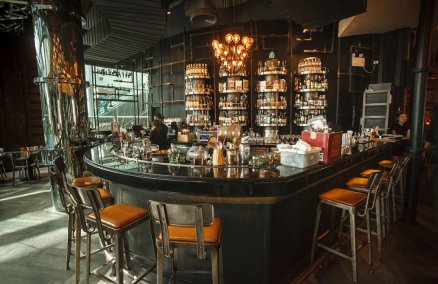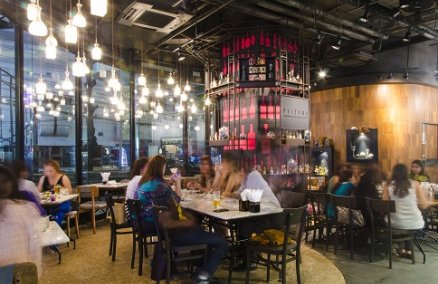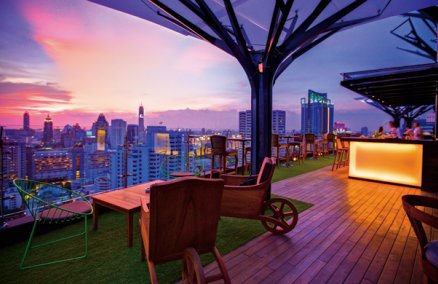Sing with the Filipinos
Filipino karaoke skills need no introduction. Is it in their blood? Are they given a microphone before they’re given a baby bottle? Go ask them at Kumpleto Restaurant and Karaoke (Soi Pridi Banomyong 40, Sukhumvit 71, open Mon-Fri 6pm-midnight, Fri-Sun 6pm-2am, 088-495-7700, www.kumpletorestaurant.com), where Filipino teachers and office workers gather for a few drinks, some darts and some serious vocalizing. Saowanee “Pien” Kaennonghu, the Thai owner and chef, says she learned to make Filipino dishes from her Filipino mother-in-law. She recommends tuyo (salty fried fish imported from the Philippines, B70), dinuguan (meat salad, B100) and binagoan baboy (fried pork with shrimp paste, B80). The restaurant also has many products from the Philippines, from baked crispy nuts to milk. But we say head straight to the karaoke room, open daily but especially late on Fri-Sat.
Eat with the Filipinos
If you’d like to tuck in without having to belt out a tune, just head to Mabuhay (1/31 Phetchaburi Soi 19, 02-255-2689, open daily 11am-11pm) to try the adobong manok (more commonly known as chicken adobo, B150). We just reviewed it (three stars!), so head to http://bit.ly/MVV09V for the full details.
Help out the Burmese
The Sammajivasil School (744 Soi Phayanak, Ratchathewi, www.tacdb-burmese.org) is a Thai elementary school on weekdays. But Myint Wai, a Burmese activist from the Thai Action Committee for Democracy in Burma, takes over at weekends with DEAR Burma (Development of Education and Awareness for Refugees from Burma), a Sunday school to teach Thai, English and computer skills to migrants at bargain rates. The computer program starts from only B400 for two months while both Thai and English are just B350 for three month courses. They’re always in need of volunteer teachers as the number of Burmese migrants applying is growing, with over 500 workers gathering here every weekend.
Tune in to Some
Laotian Sounds
Thai culture is steamrolling Laos, whether it’s our soap operas or pop. But Laotian pop hasn’t kicked the bucket just yet. Head to Bangbon district on Ekkachai Rd., near Rama 2 Rd., and you’ll find this massive market with the occasional DVD or CD stall selling luk-tung, mo-lam as well as pop songs, rock and boy bands from Laos. If you’d rather hear it live, head to Suksawasdee Market at the weekend. Concerts are held there at least twice a month with the promoter (Banjob “Kae”, 081-553-8074) sometimes importing Laotian artists to play local variants alongside Thai singers. Tickets are B100.
Tuck in to Some
Laotian Flavors
If you prefer to just have a genuine Isaan-Lao meal, head to Sirichai Market on Sunday to shop for Lao-isaan food at Talad Lao inside the main market. Here you will find Lao-Isaan vegetables and ingredients that you can’t find at any supermarket in town. The products range from unpasteurized plara (fermented fish sauce) to kai mod daeng (red ants eggs), but there’s also exotic grub like dried buffalo skin, tadpoles and ground crickets. Saeb!
Show Off Some
Burmese Style
Wondering where to pick up some of Burma’s famous beauty products, like thanaka? Head straight to Phra Khanong Market. At the entrance, turn left down a small alleyway seemingly packed with coloful clothing, and eventually you’ll find yourself in Little Burma. T-shirts, raw betel nuts and all manner of spices are just some of the Burmese goods on display. Not too far away is a well-known Burmese eatery, where you’ll be greeted by the smiling face of Dao Giri, the Nepalese-Burmese cook. Her most popular dish among Burmese expats and Thais alike is mohinga (Burmese kanomjean, B30). It’s cheap, tasty and served up in a matter of minutes.
Grab a Burmese Bite
On the topic of Burmese cuisine, some of the most authentic can be found on Soi Ramkhamhaeng 24, Yak 34. Here, there’s a handful of small eateries which cater to the many Burmese students and exchange teachers attending the nearby ABAC. One of the most popular is the family-run Shwe Myanmar which has served homegrown recipes here through a khao gaeng-like set-up for around two years now.
Say Hello to Halal Eateries
Bangkok has a variety of halal eateries, some of which see very little in the way of Thai customers. Malaysian restaurant Cili Padi (107/3, Thanon Pan, Silom Rd., Bangrak, open daily 11am-10pm, closed every first Friday of the month, 02-635-1167) brought its sizable expat clientele with it when it moved to its present location three months ago. Run by Fahmi Sabri, a Malaysian national, it serves famous dishes like nasi lemak (Malaysian national dish, B60) and kari ayam (chicken curry, B70) mostly eaten with roti (B20), while Thais particularly like the nasi goreng ayam and nasi goreng Pattaya (a local adaptation). Little slices of ASEAN can even be found in our shopping malls, like Jimbaran Bali (5th Floor, MBK Shopping Centre, open daily 10am-9pm, 081-443-6335), an Indonesian stall serving popular sets such as nasi campur (Indonesian mixed rice with soup, B190) and nasi goreng udang (Indonesian shrimp mixed fried rice with soup, B160). For dessert there’s Cibugatanjong Restaurant (465/2 Petchburi Rd., Rachatevee, beside Soi 7, open daily 10am-12pm, 02-612-1581), which has been a fave among Muslims for close to 12 years. Try the roti mataba with banana (B40), best served with fragrant hot tea (B30). They also serve a solid range of mains like their recommended goat curry (B130).
Explore Old
Vietnam Town
Bangkok started welcoming regional migration well before ASEAN even existed. For a little tour of our oldest migrant neighborhoods, start at Ban Yuan, a Vietnamese community at Soi Samsen 13 dubbed Little Saigon. The Vietnamese presence here can be traced back to the reign of King Rama III, when refugees poured in to escape wars between Cambodia and Vietnam. As they were Christians, the king placed them near the Catholic Cambodians and Portuguese who were already in town. A hundred years later, their descendants still cook up some amazing Vietnamese food. Start with Pa Kay (123/205 Dusit Avenue, Ratchawithi Rd., 02-243-4788, open daily 9am-7pm), open for more than 50 years. Try cháo canh aka guayjab yuan (Vietnamese noodle, B45), bun bi (rice noodle with grilled pork, B70) and nam nueng (Vietnamese sausage wrapped with veggies, B70), which comes with unlimited supplies of veggies and wrappers. Don’t skip dessert: the bua loy puek (taro in coconut milk, B20) is stunning. Another option is Orawan Nam Nueng Inter, on the corner of Soi 13 who has the same menu as Pa Kay. Opposite of Orawan, Nu Lek sells delicious moo yor (Vietnamese sausage, B40) and ben jue, which is the traditional Vietnamese steamed rice, for B80. But there’s more to culture than food and many in the community remain devout Christians. Head to St. Francis Xavier Church, in the same soi, where a mix of Vietnamese expats and old migrant families congregate every Sunday.
Meet the Mon
The Mon community, originally from Myanmar, is another long-established group in Bangkok. Located in Bangkradee, near Rama 2 Rd., some of the Mon here still speak their forefathers’ language and dress in traditional garb. Start at the Mon Cultural Center (Wat Bangkradee community, open daily 8am-5pm), which hosts displays of Mon antiques and crafts that detail their traditional life. They can also prepare a cultural trip for as cheap as B200 per head (contact Thawil “Pa Phu,” 081-383-7266). Another Mon community can be found at Prapradaeng, a district widely known for its celebration of Songkran festival in the Mon tradition. Stop at Wat Songtham, which was commissioned by King Rama II as a gift to the Mon people for their support against Burma. The brick ordination hall with its 56 round columns and 200-year-old Buddha are particularly striking, but the two pagodas built in the Mon architectural style are also worth a look.


















